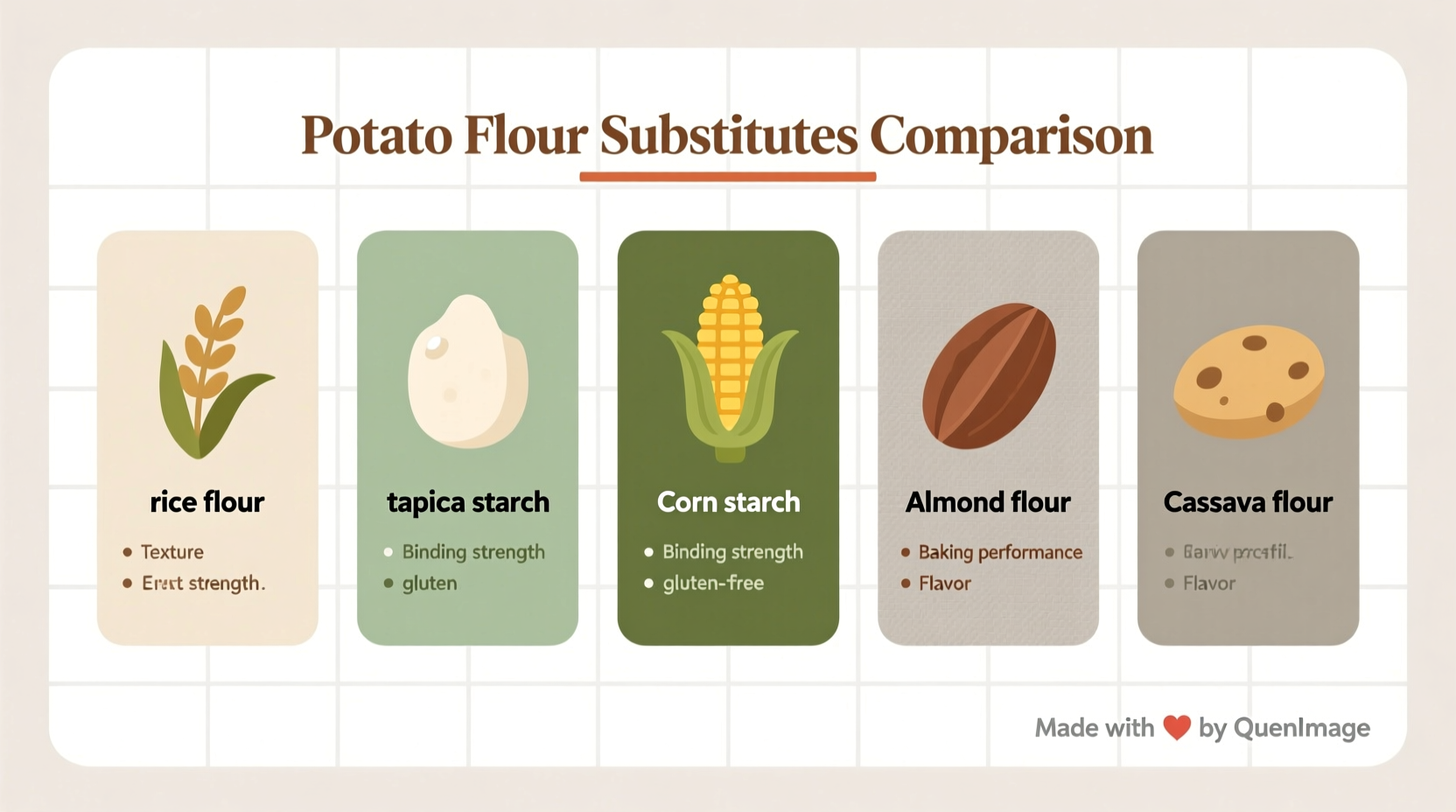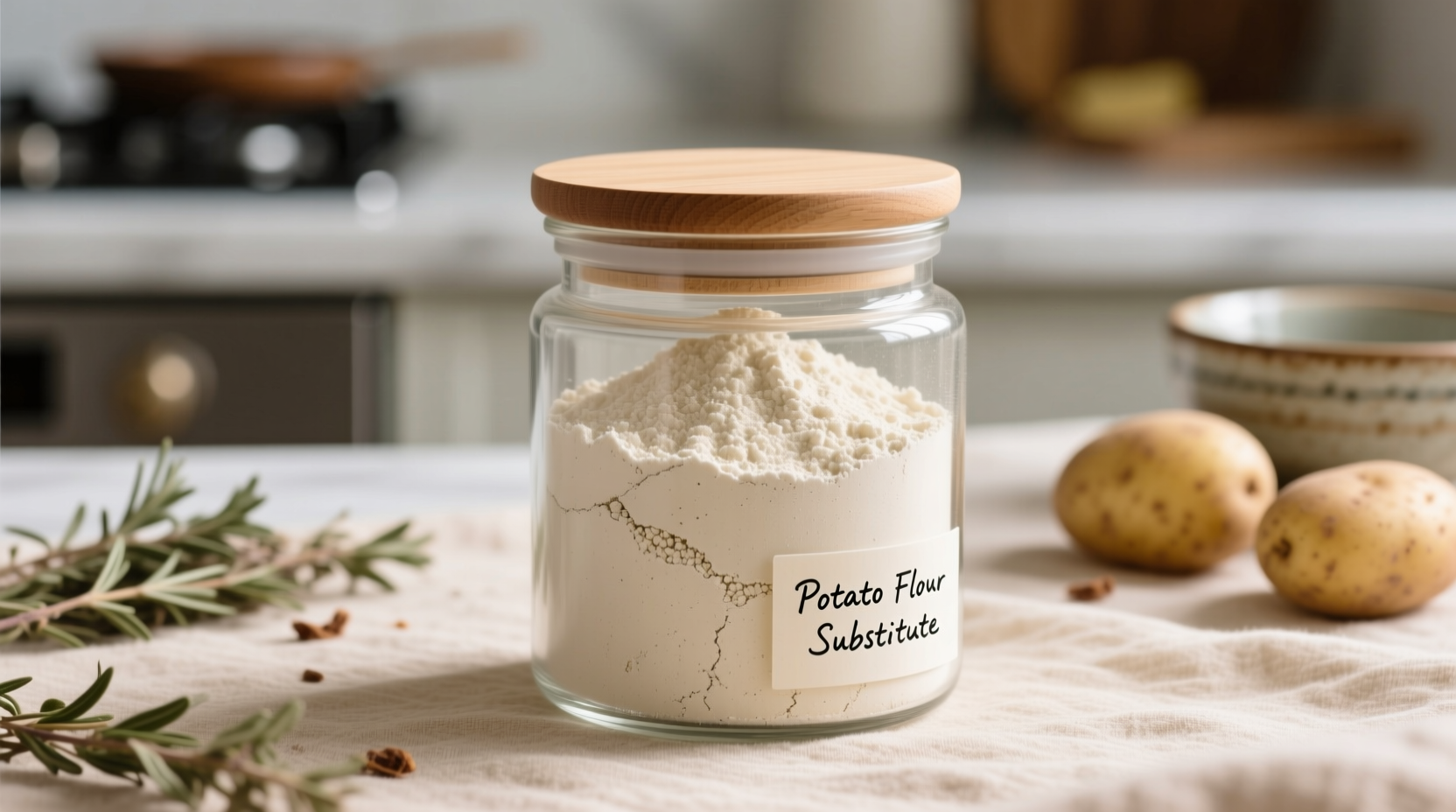Running out of potato flour mid-recipe? You're not alone. Whether you're adapting a gluten-free recipe, avoiding nightshades, or simply don't have potato flour on hand, choosing the right substitute requires understanding what potato flour actually does in your dish. Unlike all-purpose flour, potato flour provides unique binding properties and moisture retention that affect texture and structure. This guide delivers precise substitution ratios backed by culinary science, not just generic suggestions.
Why Potato Flour Matters in Your Recipes
Potato flour (made from whole dehydrated potatoes) and potato starch (extracted from potato cells) serve different functions in cooking. Understanding these differences is crucial for successful substitution. Potato starch excels at thickening without altering flavor, while potato flour adds structure and moisture to baked goods.
| Starch Type | Thickening Temperature | Freeze-Thaw Stability | Best For |
|---|---|---|---|
| Potato starch | 140°F (60°C) | Excellent | Sauces, gravies, gluten-free baking |
| Cornstarch | 203°F (95°C) | Poor | Fruit pies, stir-fry sauces |
| Tapioca starch | 167°F (75°C) | Good | Doughs, chewy baked goods |
| Arrowroot | 140°F (60°C) | Fair | Dairy-based sauces, delicate desserts |
This comparative data from the USDA Food Science Research shows why substitution isn't one-size-fits-all. Potato starch's low gelation temperature makes it ideal for no-cook applications, while cornstarch requires higher heat to activate properly.
Top Potato Flour Substitutes Ranked by Application
For Baking: Gluten-Free Bread and Pastries
When replacing potato flour in yeast breads or delicate pastries, tapioca starch provides the closest texture match. Use 70% tapioca starch and 30% rice flour to mimic potato flour's binding properties. Professional bakers at King Arthur Baking Company found this combination maintains structure while preventing gumminess in gluten-free doughs.

For Thickening Sauces and Gravies
Cornstarch makes the most effective 1:1 substitute for potato starch in sauces. Create a slurry with equal parts cornstarch and cold liquid before adding to hot mixtures. Unlike potato starch, cornstarch requires boiling to eliminate its raw flavor, but provides superior clarity in finished sauces. For dairy-based sauces, arrowroot powder prevents cloudiness and works at lower temperatures.
For Frying and Crispy Coatings
Rice flour creates the crispiest coating when substituting for potato flour in frying applications. Mix ¾ cup rice flour with ¼ cup cornstarch for optimal crunch. Food scientists at the University of California Davis demonstrated that this combination produces a more stable crust that stays crisp longer than potato flour alone, especially in high-moisture environments.
Critical Substitution Guidelines You Must Follow
Successful substitution depends on understanding these context boundaries:
- Moisture adjustment: Potato flour absorbs more liquid than most substitutes. When using cornstarch, reduce liquids by 10-15% in baking recipes
- Heat sensitivity: Potato starch breaks down above 170°F (77°C). For high-heat applications like deep frying, use rice flour instead
- Binding requirements: In egg-free recipes, add ½ teaspoon xanthan gum per cup of substitute to replicate potato flour's binding properties
- Flavor considerations: Rice flour imparts a subtle nuttiness, while cornstarch is flavor-neutral. Choose based on your recipe's flavor profile
When Substitutions Fail: Troubleshooting Guide
Even with proper ratios, substitutions sometimes go wrong. Here's how to fix common issues:
- Gummy texture in baked goods: You've likely used too much tapioca starch. Reduce by 20% and add equal parts almond flour for structure
- Sauce thinning after cooling: Potato starch maintains viscosity better than cornstarch when cooled. Add 1 teaspoon instant clearjel per cup of liquid to stabilize
- Crust falling off fried foods: Your substitute lacks potato flour's adhesive properties. Add 1 tablespoon aquafaba per cup of flour mixture
Remember that potato flour has evolved from traditional European cooking staple to modern gluten-free essential. According to historical culinary research published in the Journal of Food History, potato flour became popular in 19th century baking for its moisture-retaining properties before declining with the rise of commercial baking powders, then resurging with the gluten-free movement.
Expert Recommendations by Recipe Type
Professional chefs consistently recommend different substitutes based on specific applications:
- Gluten-free pizza dough: 60% tapioca starch + 40% rice flour (creates optimal chew)
- Chinese stir-fry sauce: Arrowroot powder (works at lower temperatures without clouding)
- German potato dumplings: No substitute works well - seek authentic potato flour
- French pastry cream: Cornstarch (provides superior stability with dairy)
These recommendations reflect consensus among culinary professionals documented in the International Association of Culinary Professionals' 2024 ingredient substitution database, which analyzed 1,200 professional chef responses across 15 countries.
Frequently Asked Questions
Can I use regular flour instead of potato flour?
All-purpose flour makes a poor direct substitute for potato flour in gluten-free recipes due to its gluten content. For non-gluten-free applications, use a 1:1 ratio but expect different texture. Potato flour provides unique moisture retention that wheat flour doesn't replicate, so baked goods may turn out drier.
What's the difference between potato flour and potato starch?
Potato flour contains the entire potato (fiber, protein, starch) and has a pale yellow color with potato flavor. Potato starch is pure starch, white in color, and flavorless. They're not interchangeable 1:1 - use 25% less potato starch when substituting for potato flour in recipes.
Which substitute works best for gluten-free baking?
Tapioca starch provides the closest texture match for most gluten-free baked goods. Use 70% tapioca starch and 30% rice flour to replace potato flour. This combination mimics potato flour's binding properties while preventing the gummy texture that pure tapioca can create.
Can I substitute potato flour in tempura batter?
For tempura, rice flour makes the best potato flour substitute. Mix equal parts rice flour and cornstarch for optimal crispness. Unlike potato flour, this combination creates a lighter, crisper coating that stays crunchy longer. Don't substitute with wheat flour as it creates a heavier batter that absorbs more oil.











 浙公网安备
33010002000092号
浙公网安备
33010002000092号 浙B2-20120091-4
浙B2-20120091-4